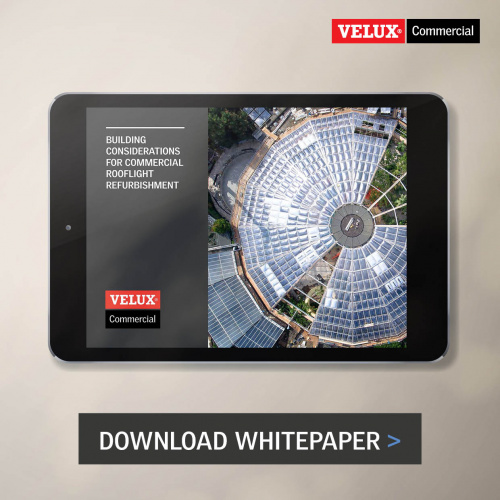Building considerations for commercial rooflight refurbishment
Introduction
Shelter is the primary function of a roof, placing significant demands on the roof structure and its components. As part of a roof, any rooflight solution must be capable of withstanding the elements. Seasonal weather cycles, combined with extreme weather events (which are becoming increasingly frequent), put a lot of strain on components as they age.
Even with regular maintenance and careful repair, roof coverings and rooflight systems eventually need replacing. Rooflight refurbishment can be carried out in isolation, or as part of a wider package of works involving other components like the waterproofing.
Our understanding of the benefits that well-designed rooflight solutions deliver has developed over time. Today, as part of the roof structure, rooflight solutions must contribute to a variety of performance and comfort measures that require a more balanced approach than simply providing functional shelter.
A roof must be considered as part of the whole building design, meaning commercial rooflight refurbishment offers a rare opportunity. It is a chance to significantly enhance the experience of using a building that may have stood for decades, or more than a century in some cases.
With 75% of the buildings in use today forecast to still be in use in 2050, there will be an increasing need for refurbishment design and specification solutions.
VELUX Commercial have produced the white paper 'Building considerations for commercial rooflight refurbishment' to help designers, specifiers, installers and building owners through the refurbishment process and to appreciate the opportunities to enhance daylighting and ventilation through the specification and installation of new rooflight solutions.
Contents
The full white paper contents headings are:
- Introduction
- Factors that influence commercial building refurbishment
- Commercial building types and refurbishment objectives
- Summary
- VELUX Commercial solutions and support
Related articles:
- A guide to daylight design within commercial buildings using bespoke structural glazing solutions
- EN 17037 Daylight in buildings
- Aspects of daylighting design covered by EN 17037
- Types of building EN 17037 applies to
- Designing daylight solutions for commercial buildings
- How to predict daylight conditions in buildings during the design phase
For more information about the specification and installation of new rooflight solutions, please visit the VELUX Commercial website.
--VELUX Commercial 16:39, 06 May 2021 (BST)
Featured articles and news
One of the most impressive Victorian architects. Book review.
RTPI leader to become new CIOB Chief Executive Officer
Dr Victoria Hills MRTPI, FICE to take over after Caroline Gumble’s departure.
Social and affordable housing, a long term plan for delivery
The “Delivering a Decade of Renewal for Social and Affordable Housing” strategy sets out future path.
A change to adoptive architecture
Effects of global weather warming on architectural detailing, material choice and human interaction.
The proposed publicly owned and backed subsidiary of Homes England, to facilitate new homes.
How big is the problem and what can we do to mitigate the effects?
Overheating guidance and tools for building designers
A number of cool guides to help with the heat.
The UK's Modern Industrial Strategy: A 10 year plan
Previous consultation criticism, current key elements and general support with some persisting reservations.
Building Safety Regulator reforms
New roles, new staff and a new fast track service pave the way for a single construction regulator.
Architectural Technologist CPDs and Communications
CIAT CPD… and how you can do it!
Cooling centres and cool spaces
Managing extreme heat in cities by directing the public to places for heat stress relief and water sources.
Winter gardens: A brief history and warm variations
Extending the season with glass in different forms and terms.
Restoring Great Yarmouth's Winter Gardens
Transforming one of the least sustainable constructions imaginable.
Construction Skills Mission Board launch sector drive
Newly formed government and industry collaboration set strategy for recruiting an additional 100,000 construction workers a year.
New Architects Code comes into effect in September 2025
ARB Architects Code of Conduct and Practice available with ongoing consultation regarding guidance.
Welsh Skills Body (Medr) launches ambitious plan
The new skills body brings together funding and regulation of tertiary education and research for the devolved nation.
Paul Gandy FCIOB announced as next CIOB President
Former Tilbury Douglas CEO takes helm.


























Comments
[edit] To make a comment about this article, or to suggest changes, click 'Add a comment' above. Separate your comments from any existing comments by inserting a horizontal line.